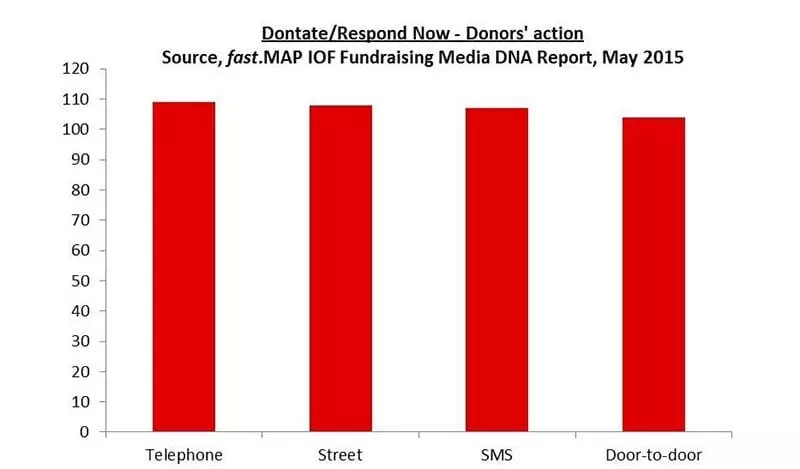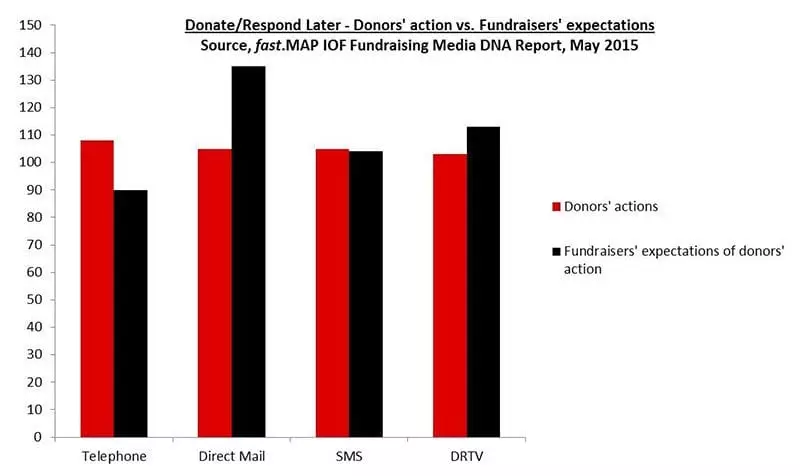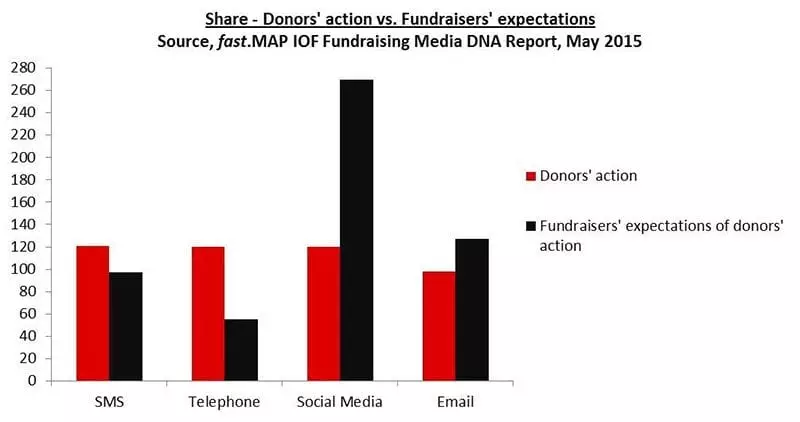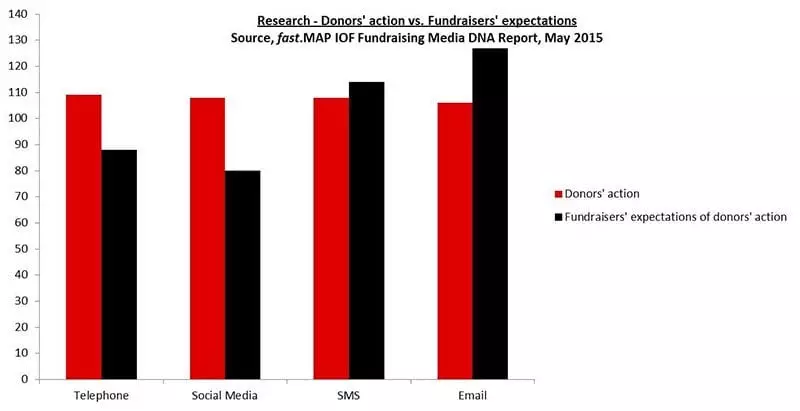Identified: the channels that make donors act
In our latest analysis of the Fundraising Media DNA report by fast.MAP and the Institute of Fundraising we look at the channels that make donors take action.
Key headlines
• Telephone has been identified as a top channel for generating donations and further research
• Face-to-face channels work well to trigger immediate donations/responses
• Fundraisers highly overestimate donors’ tendencies to share updates via social media
• Phones (both telephone & mobiles) are top channels donors use to research
• Download your copy of the Fundraising Media DNA report and infographics.
Fundraising appeals exist to motivate action
The Institute of Fundraising and fast.MAP’s Fundraising Media DNA research can help identify which actions donors are likely to take.
Some campaigns rely on a slow-burn approach, to introduce and explain the charity, encourage research and gradually persuade prospects to become supporters. Others aim to achieve more impact and generate immediate donations.
Creativity is important, but Fundraising Media DNA Research has revealed that the communication channel selected to deliver the message has a specific impact on the way people choose to respond.
Recipients have a propensity to take specific actions in response to each medium. This is why it is important to channel each appeal via the media most likely to deliver the required responses, be it slow burn, direct hit or a mix of the two.
Advertisement
Donate/Respond Now
The top four channels for generating immediate donations or responses are telephone, street-fundraising, SMS and door-to-door.
Unsurprisingly, street fundraising is second best at generating an immediate response (Donate/Respond now Index; Overall, 108) since it provides an easy, convenient and personal approach for parting with payment information.
Donate/Respond Later
Donors are highly likely to donate or respond later rather than immediately to telephone, direct mail and SMS appeals – especially telephone (Donate/respond later Index; Overall, 108 – where 100 is average), followed by direct mail and SMS (Donate/respond later Index; Overall, 105).
Telephone is also best at generating immediate responses but fundraisers underestimate its additional power as a delayed response mechanism (Donate/respond later Index; Overall Estimate, 90 vs. Actual, 108). Not everyone is able to instantly assimilate all the information supplied over the phone, but they can be inspired to research further and donate later (Research Index; Overall, 109).
The reasons for a delayed response to direct mail are easier to understand – it takes time to return a form or take whatever action is requested; and people tend to hang onto mail to read when they have more time, say at the weekend.
Share
Telephone (Share Index; Overall, 120), SMS (Share Index; Overall, 121), social media (Share Index; Overall, 120), and email (Share Index; Overall, 98) are most likely to prompt information sharing.
Hardly surprising, since “share buttons” and easy text message forwarding is inbuilt on social media and SMS platforms. But even so, fundraisers underestimate the amount of SMS and telephone sharing, while greatly over-estimating the amount of sharing on social media and via email.
Although the physical effort involved in sharing an email is much the same as for forwarding a text message, people just don’t do it as often. Maybe the shorter format of text messages makes them easier to digest, respond to and share; while longer email messages encourage people to digest and research content before taking action.
Research
Telephone, SMS, social media and email are the channels most likely to motivate research – especially telephone (Research Index; Overall, 109). Unsurprisingly, SMS and social media (Research Index; Overall, 108) were second most likely to do so, because recipients can usually use the device which carried the message to instantly access extra information online.
These channels could be used effectively in brand-awareness campaigns or for messages devised to arouse people’s curiosity.
What people say about donors’ reactions to channels?
“As the research clearly demonstrates one of the many strengths of door-to-door fundraising is its ability to reach individuals nationwide across all demographic profiles, generating an immediate memorable response. (Donate/Respond Now Index; Overall, 104) and (Donate/Respond Now Index; 35-54, 105). The opportunity to engage in meaningful dialogue about a cause with a knowledgeable fundraiser is welcomed by donors (Welcomed Index; Overall, 86). In our experience the successful outcome for charities is a 1st stage commitment with a monthly value between £8-12 on average.”
“A door-to-door conversation may be the only interpersonal engagement a supporter has with a charity, and these interactions can help donors shape future engagement from the outset. The impact of a successful interaction on the doorstep is likely to be discussed beyond family and neighbours, particularly with 35-54s (Share Index; 35-54, 105). This ripple effect means that awareness about causes is often far greater than the confines of the geographical campaign area.”
Dominic Will, Managing Director, Home Fundraising
“The Fundraising Media DNA research helps provide insight into what drives response and what people will actually do when they receive a fundraising request. This helps us all get one step closer to treating our prospects and supporters exactly how they want to be treated – as individuals.
What is most fascinating is how fundraisers have a tendency to overestimate some of the donation responses, most notably with direct mail (Donate/Respond Later Index; Estimate, 135 vs. Actual, 105). This could just be a case of over-optimism but it does show that fundraisers have to use data sensibly, think about how people engage with the medium and think about ways of encouraging response within a reasonable timeframe.”
Scott Logie, MD, REaD Group Insight
“With more information and insight on how donors respond to different fundraising communications, fundraisers can put together compelling fundraising campaigns that will be relevant and engaging to different audiences. Part of this is not only knowing what donors think and feel, but the actions that they take in response to different forms of fundraising – not just whether they donate or not.
Knowing this helps to better piece together the full experience of fundraising.
It is interesting to see the wider aspects of actions donors take. For example, when receiving an SMS individuals are most likely to ‘share’ or ‘research further’ alongside making a potential donation – knowing this fundraisers can make sure they have easy and simple links to enable individuals to take a number of actions such as sharing with friends or prompting research on their website.
A key learning from the research is a reminder for fundraisers to not fall in to the trap of assuming that just because it’s easy for people to do something, they will. Social media is one of the most shared channels, but fundraisers overestimate the frequency with which this sharing occurs (Share Index; Estimate, 270 vs. Actual, 120). While it may be the case that it’s easy to share social media messages, donors won’t do this as a matter of course, the content has to be engaging and compelling.“
Daniel Fluskey, Head of Policy and Research, Institute of Fundraising
“It is interesting that the phone channels (Research Index; Telephone Overall, 109), (Research Index; SMS Overall, 108) as well as social media and email, drive people to research further. The hard work of any marketing campaign must be supported by a website that reflects the nature and topics covered. People like to feel informed, and know that more information is available if they want it.
If donors are so willing to research further and look into more details about campaigners, perhaps fundraisers should consider doing the same. Pre-testing campaigns and proposition ideas can help establish not just what works, but why people are so willing to engage with it. Perhaps this can help fill some of the gaps in a campaign, converting more prospects into donors.”
David Cole, Managing Director, fast.MAP








